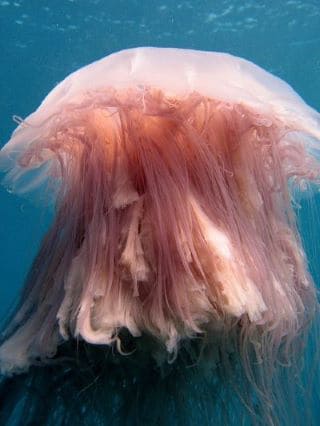Home › Ocean Life › Marine › Invertebrates › Jellyfish › Lion's Mane
Facts about the Lion's Mane Jellyfish
[Phylum: Cnidaria] [Class: Scyphozoa (true jellyfish)] [Order: Semaeostomeae] [Family: Cyaneidae]
There is an unmistakable invertebrate with 120-feet long trailing tentacles that drifts near the surface of the water while it feeds mostly on plankton.
This guide contains fun and interesting facts about the "true jelly" species (Cyanea capillata) including where they live and how this enormous creature survives without a brain.
The Giant Jellyfish Habitat and Distribution
Scientists generally refer to this gigantic jellyfish species as the lion's mane, because it resembles the fur of an adult male lion.
But, besides its actual taxonomic classification of "Cyanea capillata", other common names include:
- The giant jellyfish
- Arctic red jellyfish
- The hair jelly
Fact: Its size even rivals the largest of all mammals - the blue whale.
So, where does it live? By and large, the largest jelly species thrives best in cold water. Thus, they inhabit most of the world's oceans, especially the Arctic, Northern Atlantic, and the Northern Pacific.
Nonetheless, you can also find solitary specimens living around the shorelines of Scandinavia, the English Channel, and even parts of the Irish Sea.
There are substantiated recordings that show sightings of this pelagic jellyfish drifting into southwestern regions of the Baltic Sea. But, the low salinity in this area of Northern Europe means they would be unable to breed.
Lion's Mane Behaviour and Characteristics
The optimum time of year to spot them drifting along the shore is late summer time and into early autumn. This is when strong water currents have the most influence over their slow pulsating body mass.
But, unlike the smallest jellyfish (Irukandji), these huge pelagic jellies live a completely solitary lifestyle and they almost never travel the oceans in groups.
In spite of this, or because of it, the lion's mane jellyfish spends most of its short life at or near to the surface. So, it would be rare to find one living at a depth deeper than twenty (20) metres (66 feet).
 It shares most of the typical jellyfish anatomy and body parts that the smaller species display.
It shares most of the typical jellyfish anatomy and body parts that the smaller species display.
Here's the thing:
The huge "mane" of hair-like tentacles hangs much lower underneath the dome-shaped reddish yellow bell.
The mouth (known as a cluster of oral arms) is also on the underside with the rest of the eight clusters. Some of the largest specimens can have up to 1,200 tentacles.
How Big is a Lion's Mane Jellyfish?
An average diameter for the bell of Cyanea capillata is about forty (40) centimetres (1.5 feet). But, it can grow to about two metres (6.5 feet).
Fun Fact: The lion's mane jellyfish has bioluminescent abilities. It can produce its own light so it can glow in the darkness underwater.
How Powerful is a Lion's Mane Jellyfish Sting?
The hydroid sting of jellyfish tentacles contains nematocysts (jellyfish toxins), most of which can be poisonous to humans. In most cases, the powerful sting of the lion's mane jellyfish is very painful with some localised redness (welts).
Even so, unlike the Chirodectes maculatus (box jellyfish), healthy individuals should survive the stings and using white vinegar may help to deactivate the stinger cells. Medical attention may be required in the most severe cases (e.g. contact with multiple tentacles).
What Do Lion's Mane Jellyfish Eat?
The lion's mane jellyfish is a foraging predator. In other words, it uses the powerful sting of its extending tentacles to ensnare tiny marine crustaceans and small fishes.
They also have a somewhat cannibalistic diet and they will eat some of the smaller species of jellyfish for survival.
How Do Lion's Mane Jellyfish Reproduce?
Jellyfishes can achieve sexual reproduction in the medusa stage. Some can also achieve asexual reproduction in the polyp stage. The four stages in the one year lifespan of the lion's mane jellyfish are:
- Larval
- Polyp
- Ephyrae
- Medusa
The typical breeding season for lion's mane jellyfishes is March and again in early May. Through a process called external fertilisation, the larvae will take at least one month to develop.
During the reproductive process, a female will carry fertilised eggs inside a tentacle. This is where the eggs will develop and grow into larvae. Once they are old enough, she will deposit them onto a solid surface so they can grow into polyps.
When the polyps reproduce asexually, they create stacks of tiny undeveloped medusae (ephyrae). When these individuals break away from the stacks they will develop further into the mature medusa stage.
Threats and Predators
Localised scientific research suggests jellyfishes do better than most other marine invertebrates in areas affected by human activities. Typical examples include garbage pollution, climate change, and overfishing.
As a result, there are few known threats to large adult lion's mane jellyfishes. The smaller species often fall prey to anemones, large fish (e.g. ocean sunfish), seabirds, and most species of sea turtles, especially the leatherback sea turtle.
Related Information and Help Guides
- A to Z of Marine Biology and Sea Life Terms
- Blue Dragon Sea Slug Facts and Information
- Box Jellyfish Sting Treatment First Aid
- Different Parts and Anatomy of a Jellyfish
- First Aid for Portuguese Man O' War Sting
Note: The short video [2:07 minutes] presented by "Deep Marine Scenes" contains stunning footage and interesting facts about the largest jellyfish in the world (Cyanea capillata).